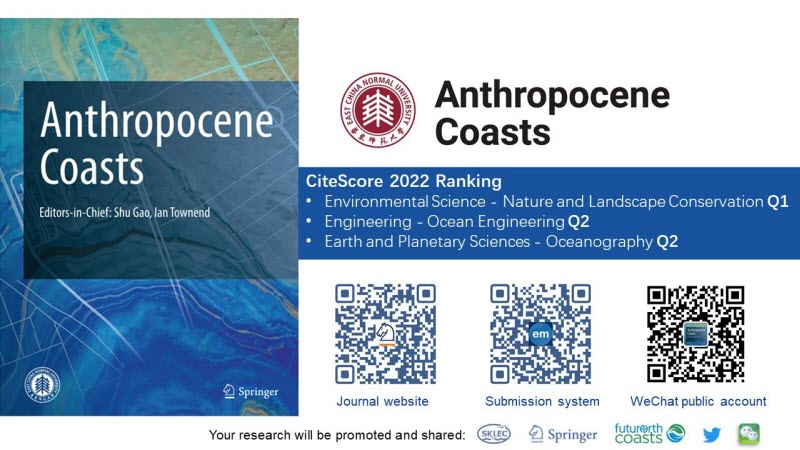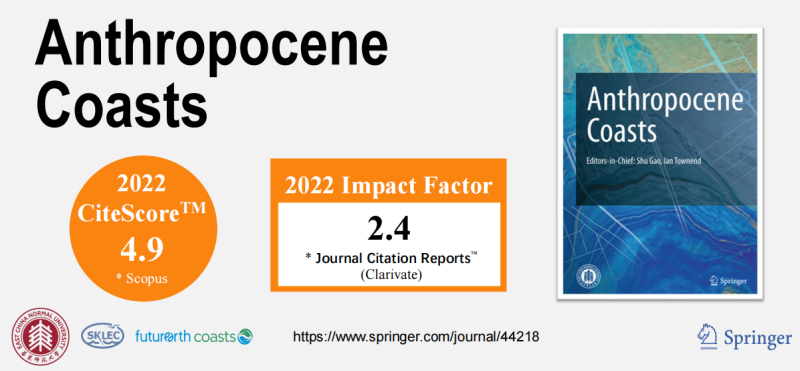Anthropocene Coasts, an open access journal, publishes multidisciplinary research that aims to understand and predict the effects of human activities, including climate change, on estuarine and coastal regions. Anthropocene Coasts publishes original research articles, reviews, topical communications, letters and book reviews.
The Anthropocene is the period during which human activities have had a marked, and often decisive, environmental impact on the Earth, whilst coasts embraces all aspects of the land–sea interface. Anthropocene Coasts therefore seeks to identify and document the influence of human activities on contemporary coastal processes (physical, biological, and chemical processes across the land–sea interface) and the implications for other aspects of these systems including social, economic, and legal considerations.
Anthropocene Coasts is the first international open access journal that combines the concept of the Anthropocene context and intersects the disciplines of coastal ocean with the multidisciplinary disciplines of sustainable development and environmental protection. It covers the disciplines of oceanography, geography, ecology, sustainable development, coastal engineering and environmental engineering. Anthropocene Coasts is presently abstracted and indexed in 18 databases, such as Scopus, ESCI (Web of Science), and CNKI.
Anthropocene Coasts’ CiteScore 2022 is 4.9 and has entered the CiteScoreTM rank 2022 of Q1 academic journals!Both the 2022 Journal Impact Factor (JIF) And the Journal Impact Factor Without Self Citations of Anthropocene Coasts are 2.4.
The article processing charge (APC) this year is fully covered by East China Normal University (.free Open Access for both authors and readers.).
- Understand and predict the effects of human activities, including climate change, on estuarine and coastal regions
- Formulate new blueprints for coastal and deltaic regions in terms of future development.
- Resources and their variations/changes;
- Environmental influences associated with natural and human-induced processes;
- Changes in coastal hazard patterns and the implications for safety;
- The role of coastal ecosystem services and how these may change;
- Implications of population growth and urban expansion on the coast;
- Adaptation in response to change and methods to enhance coastal sustainability and resilience;
- Interactions with society (including aspects such as economics, planning, policy/legislation and regulation, social mobility, technology, engineering, and risk management);
- Observations, modelling, and theoretical advances to better detect and understand change.
- AI based research/ machine learning (data training or no datasets) on Coastal management
- Articles — Studies of broad scope that report new and original research with international significance;
- Reviews — Critical syntheses of information on important topics;
- Topical Communications — New concepts, techniques, methodologies, projects or commentaries on topical subjects, matters for debate, or to highlight uncertainties or knowledge gaps. (length should not exceed 3500 words);
- Letters — Short reports of original research focused on specific findings of interest to the wider community (length should not exceed 1500 words); and
- Book reviews – short review of recently published books or open access reports that are likely to be of interest to the coastal community, with a length of up to 1500 words.
Note: Manuscript should be as comprehensive as possible. Data supporting the results should be provided directly in the paper, included in the associated supplemental materials, or archived in an appropriate public archive.
Submissions that do not have a clear human or multidisciplinary component are more suited to one of the existing discipline-based journals and are unlikely to be considered for publication. (Please refer to “Anthropocene Coasts: 5 years on”.)


